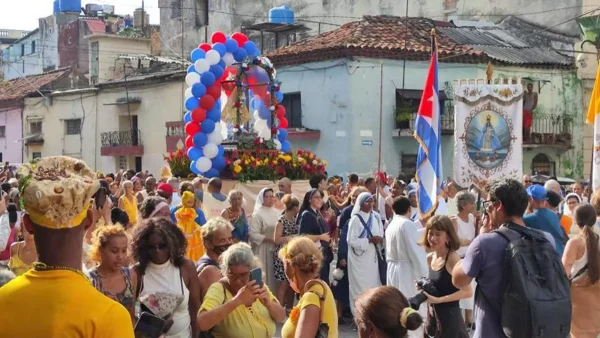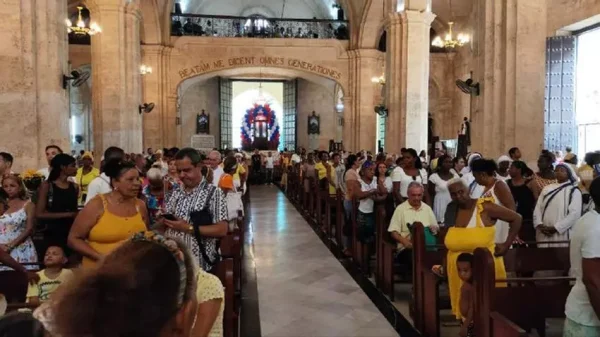Cubans Revere Patron Saint Amid Crisis & Mass Exodus

The procession, which a few years ago had a certain festive and merry touch, was this time more introverted and circumspect.
By Natalia Lopez Moya (14ymedio)
HAVANA TIMES – The heat and lack of water in wide areas of the Cuban capital did not prevent the church of the Virgen de la Caridad del Cobre on the corner of Manrique and Salud, in Central Havana, from being filled with devotees, who celebrate on September 8 the day of the Patron Saint of Cuba. The effects of inflation and the mass exodus, however, were noticeable.
The bouquet of sunflowers, with its yellow petals in tribute to the saint, fondly called Cachita, now costs 1,000 Cuban pesos, twice the price of two years ago. On this occasion, the deep economic crisis has also reduced the number of offerings left on the altar at the entrance to the church, including candles, holy cards and gifts to the Virgin.
“Coming here was already a sacrifice,” says Celeste, 68, who arrived with her daughter and a grandson. “This is the only family I have left in Cuba, and we have come to ask Oshún (the equivalent of the Virgin of Charity del Cobre in the Yoruba religion) to send them quickly and safely on the way.” The family entered the church shortly after four in the afternoon for the mass given by Cardinal Juan de la Caridad García, archbishop of San Cristóbal de La Habana.

In the large enclosure, the average age of those present exceeded 50 years, a sign of the exodus suffered by the Island. Some children, accompanied by their grandparents, stood out among so many gray hairs and gave some amusement in the middle of the sober ceremony. At the base of an arch supported by regal columns, a Latin phrase contradicted the reality of the missing young people: “beatam me dicent omnes generations” (all generations will hold me blessed).
In contrast to the small number of young people and children, those who never miss the date are the police and state security agents who closely monitor, every year, the commemoration of September 8 and, especially, the procession that runs through several streets of one of the most populated municipalities of Havana. The rectangle formed by Manrique, Zanja, Galiano and Reina streets is the route along which Cachita’s followers walk, accompanied by priests, nuns, parishioners, santeros (practitioners of Santería) and segurosos (security guards).
From Galiano Avenue, metal fences and several police officers controlled the passage to the Havana church where tribute is paid to “the mother of all Cubans.” In the vicinity of the church, the surveillance cordon was stricter and, significantly, the large mountains of garbage that are now part of the landscape had disappeared from the area. Now that the filth was further away, the sellers were able to unfold their tables and display their necklaces, wood carvings with the mambisa* virgin’s image, bouquets of flowers and dolls dressed in yellow. But unlike other years, the merchants did not have an avalanche of customers this Sunday, because some were deterred by the high prices, and others, simply, weren’t able to make the journey.
Adorned with balloons with the colors of the Cuban flag, the image of the Virgin of Caridad del Cobre on procession was protected inside a glass case. After five in the afternoon the procession with Cachita peeked through the door of the church, and she was greeted with applause, tears and hundreds of raised arms trying to capture the moment with their mobile phones.
“There are many people but fewer than in other years,” said a young man who was trying to broadcast live on his social networks the moment of the Virgin’s departure. “I barely have 4G so I don’t know if the images are showing,” he said. “I’m trying to send the video to my sisters, who left a few months ago and used to come to this parish a lot. One is in Madrid and the other in Valencia, but they are still very devoted to Cachita.”
Smiles were also scarce. The procession that a few years ago had a certain touch of fiesta and revelry was this time more introverted and circumspect. There were thinner faces, fewer petals falling from the balconies due to the high price of flowers, more calm and fewer spontaneous screams like the ones a few years ago that broadcast the need for a national understanding to “accept us all, under the mantle of Cachita.”

During the procession, applause was heard, shouts of “Long live the Virgin” and tunes like “If you go to Cobre, I want you to bring me a a little Virgin of Charity.” Megaphone in hand, the Cardinal asked the Patron Saint of Cuba to help the residents of the Island to “solve the serious economic, political and social problems” they suffer in a debacle for which there is no solution in the short or medium term.
In other parishes of the country, processions and similar masses were held, especially the one that took place at the Cobre Sanctuary in Santiago de Cuba, where dozens of people celebrated the 412nd anniversary of the discovery of the image of the Virgin.
For the rest, the day was influenced from the beginning by prayers and complaints about the difficult situation that Cuban families are going through. For the occasion, the superior of the Daughters of Charity in Cuba, Nadieska Almeida, published a text on Facebook describing the deep crisis on the Island. “I also suffer as a Cuban when I have no strength to get up, when hope seems to be extinguished.” The nun regrets “so many unnecessary deaths due to hunger, lack of resources and, what is more serious, negligence, because our damage is so severe that we stop caring.”
*Translator’s note: In 1915, several veterans of Cuba’s War of Independence (“mambises”) wrote to Pope Benedict XV, asking him to proclaim the Virgin of Charity del Cobre as the patroness saint of Cuba.
Translated by Regina Anavy for Translating Cuba.





